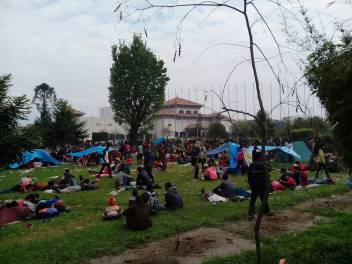 The earthquake that hit Nepal on 25 April is estimated to have affected 8 million people. Over 6,200 people have died, although this figure continues to rise.
The earthquake that hit Nepal on 25 April is estimated to have affected 8 million people. Over 6,200 people have died, although this figure continues to rise.
HelpAge International has been working with local partner organisations in Nepal since 2001. Following the earthquake, our initial focus is to provide older people with the basic assistance they need to survive with dignity.
Older people’s needs not met
We are also working to ensure other organisations include older people in their responses. Even though older people are among the most vulnerable in a disaster, their needs are often not understood or addressed by humanitarian agencies.
As a result, older people’s specific needs are not met and the general humanitarian assistance often does not reach older people.
In order to estimate the likely scale of response needed for older people, we analysed the existing demographic data on Nepal. It shows people aged 60 and over comprise over 8% of population.
650,000 older people in need
In Western region, one of the worst affected by the earthquake, where many younger adults have moved to urban areas in search of work, older people comprise almost 11% of the population. We estimate that about 650,000 older women and men are in need of humanitarian assistance.
Our analysis also shows many households are headed by older people. In the earthquake affected districts, an average of 10% of households are headed by older people. Many are widows and widowers who are often among the poorest and most vulnerable.
It is crucial to ensure that these particularly vulnerable households are included in the humanitarian response.
High poverty rates
The high poverty rate in Nepal will also have an impact on older people’s ability to reach and access assistance. Almost a quarter of all Nepalese live below the international poverty line of US$1.25 a day.
Many Nepalese enter old age after a life of economic poverty, little education and poor healthcare. As a result, older people are frequently among the poorest in communities. Limited income undermines people’s ability to recover from a crisis.
Older people also need health services that addresses their particular health needs, including the debilitating and potentially fatal chronic diseases that affect so many people in older age such as hypertension, diabetes and arthritis.
In the aftermath of the earthquake, there is a necessary focus on medical care for injuries and other direct consequences of the earthquake. However it is important also to manage pre-existing conditions such as chronic diseases in order to prevent avoidable deaths.
Our recommendations
The following measures are needed to ensure older people receive the humanitarian assistance they need:
- Older people should be included and consulted in first phase assessments so that their needs are understood and programmes can be designed with them in mind.
- The psychological impact of the loss of family members, homes and community ties must be recognised and addressed in all age groups, including older people.
- Mobility aids such as walking sticks and glasses must be provided to enable older people to be mobile and care for themselves and their dependents.
- Emergency health services must address the health needs of older people, including the most prevalent chronic illnesses.
- Shelters must be accessible for older people and people with disabilities. This requires ramps, grab rails and doorways that are wide enough to allow wheel chair access.
- Warm clothing and adequate bedding should be provided for older people as they suffer particularly as sleeping on cold or damp surfaces can cause joint problems to become acute and debilitating.
- Employment, cash for work and other livelihoods opportunities should be made available to older people. Many people in Nepal depend on being able to work into old age in order to support themselves and their families and dependents.
- Food and relief should be distributed in packages that are small and light enough for older people to be able to carry from distribution points.
- Food should be provided that is appropriate to older people’s needs – easily chewable, culturally appropriate and addressing older people’s micronutrient needs.
- All distributions should be carried out in safe accessible locations and take into account the limited mobility of many older people.
- At distribution points, priority should be given to vulnerable people and seating provided for those who cannot stand.
- Arrangements should be made to ensure relief goods reach people who cannot access distribution points, for example by providing outreach, home delivery or a system for relief goods to be collected by a trusted proxy.
How you can help
You can support older people whose lives have been devastated by the Nepal earthquake:
